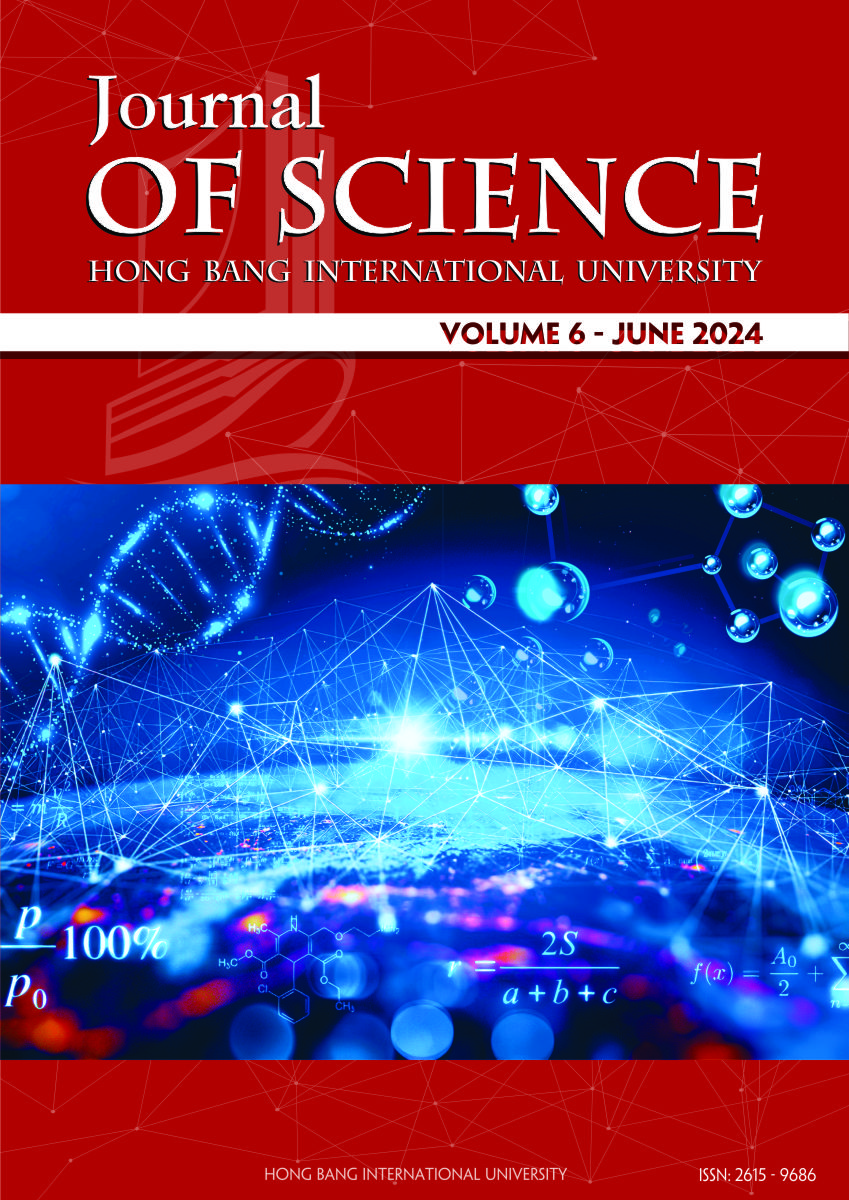Evaluation of in silico antidiabetic activity of phytocompounds of wild bitter gourd on DPP4 target
Các tác giả
DOI: https://doi.org/10.59294/HIUJS.VOL.6.2024.627Từ khóa:
khổ qua rừng, chống đái tháo đường, in silico, docking phân tử, DPP4Abstract
Wild bitter gourd (Momordica charantia var. abbreviata Ser.) shows diverse pharmacological effects, especially containing many phytocompounds with potential antidiabetic activity. Forty-one bioactive compounds were screened for antidiabetic activity through the inhibition of DPP4 (dipeptidyl peptidase 4) by molecular docking with AutoDock Vina software. Momordicoside T (-10.1 Kcal/mol), Momordicoside B (-9.9 Kcal/mol), Momordicoside F1 (-9.8 Kcal/mol), and Momordicoside I (-9.7 Kcal/mol) showed the strongest interaction with the DPP4 target compared to co-crystallized ligand and reference drug Vildagliptin (-6.9 Kcal/mol). These Momordicosides formed many strong hydrogen bonds at the DPP4 active site. In particular, Momordicoside T established the most hydrogen bonds with bond lengths ranging from 1.92-2.94 Å. The structure linked with sugar moieties increased the hydrogen bond formation and binding affinity of these phytocompounds with DPP4. Therefore, these compounds could be potential molecules to develop new antidiabetic drugs on DPP4.
Tài liệu tham khảo
[1] S. Jia, M. Shen, F. Zhang and J. Xie, “Recent advances in Momordica charantia: Functional components and biological activities,” Int J Mol Sci., vol 18, p. 2555, 2017. DOI: 10.3390/ijms18122555.
DOI: https://doi.org/10.3390/ijms18122555[2] E. Richter, T. Geetha, D. Burnett, T. L. Broderick, J. R. Babu, “The effects of Momordica charantia on type 2 diabetes mellitus and Alzheimer's disease,” Int J Mol Sci., vol 24, p. 4643, 2023. DOI: 10.3390/ijms24054643.
DOI: https://doi.org/10.3390/ijms24054643[3] B. Joseph and D. Jini, “Antidiabetic effects of Momordica charantia (bitter melon) and its medicinal potency,” Asian Pac J Trop Dis., vol 3, pp. 93-102, 2013. DOI: 10.1016/S2222-1808(13)60020-1.
DOI: https://doi.org/10.1016/S2222-1808(13)60052-3[4] B. Xu, Z. Li, T. Zeng, J. Zhan, S. Wang, C. T. Ho, and S. Li, “Bioactives of Momordica charantia as potential anti-diabetic/hypoglycemic agents,” Molecules, vol. 27(7), p. 2175, 2022. DOI: 10.3390/molecules27072175.
DOI: https://doi.org/10.3390/molecules27072175[5] S. Supandi, M. S. Wulandari, E. Samsul, A. Azminah, R. Y. Purwoko, H. Herman, H. Kuncoro, A. Ibrahim, N. S. S. Ambarwati, R. Rosmalena, R. N. Azizah, S. Paramita and I. Ahmad, “Dipeptidyl peptidase IV inhibition of phytocompounds from Artocarpus champeden (Lour.) Stokes: In silico molecular docking study and ADME‑Tox prediction approach,” J. Adv. Pharm. Technol. Res., vol. 13, pp. 207-215, 2022. DOI: 10.4103/japtr.japtr_376_22.
[6] P. C. Em, V. V. Lenh, V. N. Cuong, N. D. Ngoc Thoi, L. T. Tuong Vi and N. T. Tuyen, “In vitro and in vivo antidiabetic activity, isolation of flavonoids, and in silico molecular docking of stem extract of Merremia tridentata (L.),” Biomed Pharmacother., vol. 146, p. 112611, 2022. DOI: 10.1016/j.biopha.2021.112611.
[7] P. C. Em, L. T. Tuong Vi and N. T. Tuyen, “Design, synthesis, bio-evaluation, and in silico studies of some N-substituted 6-(chloro/nitro)-1H-benzimidazole derivatives as antimicrobial and anticancer agents,” RSC Adv., vol. 12(33), pp. 21621-21646, 2022. DOI: 10.1039/d2ra03491c.
DOI: https://doi.org/10.1039/D2RA03491C[8] P. C. Em, N. T. Tuyen, N. D. Hanh Nguyen, V. D. Duy and D. T. Hong Tuoi, “Synthesis of a series of novel 2-amino-5-substituted 1,3,4-oxadiazole and 1,3,4-thiadiazole derivatives as potential anticancer, antifungal and antibacterial agents”, Med. Chem., vol. 18, pp. 558-573, 2022. DOI: 10.2174/1573406417666210803170637.
DOI: https://doi.org/10.2174/1573406417666210803170637[9] P. C. Em, L. T. Tuong Vi, T. P. Long, T. N. Huong-Giang, N. L. Bao Khanh and N. T. Tuyen, “Design, synthesis, antimicrobial evaluations and in silico studies of novel pyrazol-5(4H)-one and 1H-pyrazol-5-ol derivatives,” Arab. J. Chem., vol. 15(3), p. 103682, 2022. DOI: 10.1016/j.arabjc.2021.103682.
DOI: https://doi.org/10.1016/j.arabjc.2021.103682[10] P. C. Em and N. T. Tuyen, “Design, microwave-assisted synthesis, antimicrobial and anticancer evaluation, and in silico studies of some 2-naphthamide derivatives as DHFR and VEGFR-2 Inhibitors,” ACS Omega., vol. 7(37), pp. 33614-33628, 2022. DOI: 10.1021/acsomega.2c05206.
DOI: https://doi.org/10.1021/acsomega.2c05206[11] P. C. Em, L. T. Tuong Vi, L. H. Huong Ha, V. T. Bich Ngoc, B. V. Long, V. T. Thao, D. V. Duy, T. N. Ngoc Vi, N. L. Bao Khanh and N. T. Tuyen, “N,2,6-Trisubstituted 1H-benzimidazole derivatives as a new scaffold of antimicrobial and anticancer agents: Design, synthesis, in vitro evaluation, and in silico studies,” RSC Adv., vol. 13(1), pp. 399-420, 2023. DOI: 10.1039/d2ra06667j.
DOI: https://doi.org/10.1039/D2RA06667J[12] S. Supandi, M. S. Wulandari, E. Samsul, A. Azminah, R. Y. Purwoko, H. Herman, H. Kuncoro, A. Ibrahim, N. S. S. Ambarwati, R. Rosmalena, R. N. Azizah, S. Paramita and I. Ahmad, “Dipeptidyl peptidase IV inhibition of phytocompounds from Artocarpus champeden (Lour.) Stokes: In silico molecular docking study and ADME‑Tox prediction approach,” J. Adv. Pharm. Technol. Res., vol. 13, pp. 207-213, 2022. DOI: 10.4103/japtr.japtr_376_22.
DOI: https://doi.org/10.4103/japtr.japtr_376_22[13] M. Zhang, L. Zhu, G. Wu, T. Liu, X. Qi and H. Zhang, “Rapid screening of novel dipeptidyl peptidase-4 inhibitory peptides from pea (Pisum sativum L.) protein using peptidomics and molecular docking,” J. Agric. Food Chem., vol. 70, pp. 10221-10228, 2022. DOI: 10.1021/acs.jafc.2c03949.
DOI: https://doi.org/10.1021/acs.jafc.2c03949[14] D. Istrate and L. Crisan, “Natural compounds as DPP-4 inhibitors: 3D-similarity search, ADME toxicity, and molecular docking approaches,” Symmetry, vol. 14, p. 1842, 2022. DOI: 10.3390/sym14091842.
DOI: https://doi.org/10.3390/sym14091842[15] R. Hazarika, P. Parida, B. Neog and R.N. Yadav, “Binding Energy calculation of GSK-3 protein of human against some anti-diabetic compounds of Momordica charantia Linn. (Bitter melon),” Bioinformation, vol. 8(6), pp. 251-254, 2012. DOI: 10.6026/97320630008251.
DOI: https://doi.org/10.6026/97320630008251Tải xuống
Tải xuống: 87











